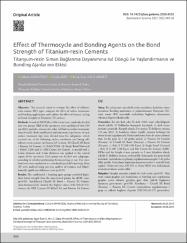| dc.contributor.author | Sayın Özel, Gülsüm | |
| dc.contributor.author | Akın, Ceyda | |
| dc.contributor.author | Oğuz Ahmet, Bebek Serra | |
| dc.date.accessioned | 2021-08-03T07:32:16Z | |
| dc.date.available | 2021-08-03T07:32:16Z | |
| dc.date.issued | 2021 | en_US |
| dc.identifier.citation | Sayın Özel, G., Akın, C. ve Oğuz Ahmet, B. S. (2021). Effect of thermocycle and bonding agents on the bond strength of titanium-resin cements. Bezmialem Science, 9(3), 344-350. https://dx.doi.org/10.14235/bas.galenos.2020.4555 | en_US |
| dc.identifier.issn | 2148-2373 | |
| dc.identifier.uri | https://dx.doi.org/10.14235/bas.galenos.2020.4555 | |
| dc.identifier.uri | https://hdl.handle.net/20.500.12511/7654 | |
| dc.description.abstract | Objective: This research aimed to evaluate the effect of different resin cement (RC) types, compare the effect of surface treatments and bonding applications and evaluate the effect of thermal cycling on bond strengths to Titanium (Ti) surfaces.
Methods: A total of 240 Ti discs (10x3 mm) were randomly divided into two groups. Half of the specimens were sandblasted with 110 mu m Al2O3 particles, whereas the other half had no surface treatments (non-treated). Both sandblasted and non-treated specimens of each surface treatment type were divided into five subgroups, which received one of the following surface conditions and luting selfadhesive resin cement: (a) Panavia SA Cement, (b) Clearfil SE Bond + Panavia SA Cement, (c) RelyX U200, (d) Single Bond Universal + RelyX U200 and (e) MIS Crown Set Cement. A mould with a 4-mm diameter and 2-mm thickness was applied to the central region of the specimens. Each group was divided into subgroups, according to whether performing thermocycling or not. The shear bond tests were conducted at a crosshead speed of 1 mm/min. Data (N) were analysed using one-way analysis of variance and Tukey's honestly significant difference tests (p<0.05).
Results: The sandblasted + bonding agent groups provided higher shear bond strength than the non-treated groups for all RC types (p<0.05). Sandblasted Clearfil SE Bond + Panavia SA Cement (non-thermocycled) showed the highest values (182.761 +/- 41.55), whereas the MIS Cement (17.681 +/- 9.33) and Panavia SA Cement (15.32 +/- 7.38) non-treated (thermocycled) groups had the lowest values.
Conclusion: Sandblasting and bonding agents can improve bond strength. The thermocycling period decreased the bond strength values for all groups. | en_US |
| dc.description.abstract | Amaç: Bu çalışmanın amacıfarklı rezin simanların, kumlama yüzey işleminin, bonding ajanlarının ve yaşlandırmanın Titanyum (Ti)- rezin siman (RS) arasındaki makaslama bağlanma dayanımına etkisinin değerlendirilmesidir. Yöntemler: İki yüz kırk adet Ti disk (10x3 mm) yüksekliğinde olacak şekilde Ti bloklardan kazınarak hazırlandı ve akril reçine içerisine gömüldü. Rastgele olarak 2’ye ayrılan Ti disklerin yarısına 110 µm Al2 O3 ile kumlama işlemi yapıldı, yarısına herhangi bir yüzey işlemi uygulanmadı. Hem kumlanmış hem de yüzey işlemsiz olan bu iki grup da 5 alt gruba ayrıldı. a) Panavia SA Cement (Kuraray) b) Clearfil SE Bond (Kuraray) + Panavia SA Cement (Kuraray) c) Rely X U-200 (3M-Espe) d) Single bond Universal + Rely X U-200 (3M-Espe) and Mis Crown Set Cement (MIS). RS’ler özel bir kalıpla 4 mm çapında ve 2 mm kalınlıkta olacak şekilde Ti disklerin ortasına yerleştirildi. Sonrasında her grup kendi içerisinde yaşlandırma uygulanıp uygulanmamasına göre 2 alt gruba daha ayrıldı. Makaslama bağlanma dayanımı testleri 1 mm/dk hızla yapıldı. Veriler one-way ANOVA ve Tukey HSD testi kullanılarak istatistiksel olarak analiz edildi. Bulgular: Gruplar arasında anlamlı bir fark vardır (p<0,05). Tüm rezin siman grupları için kumlanmış ve bonding ajan uygulanmış gruplar, yüzey işlemsiz gruplara göre daha yüksek bağlanma dayanımı göstermiştir (p<0,05). Kumlama + Clearfil SE Bond (Kuraray) + Panavia SA Cement (yaşlandırma uygulanmamış ) grup en yüksek bağlantı değerini (182,761±41,55) gösterirken, MIS Cement (17,681±9,33) ve Panavia SA Cement (15,32±7,38) yüzey işlemsiz (yaşlandırma uygulanmış) gruplar en düşük değerleri göster-miştir. Sonuç: Kumlama ve bonding ajan uygulaması bağlanma dayanımı arttırmıştır. Isıl döngü ile yaşlandırma tüm gruplar için bağlantı değerlerini düşürmüştür. | en_US |
| dc.language.iso | eng | en_US |
| dc.publisher | Bezmiâlem Vakıf University | en_US |
| dc.rights | info:eu-repo/semantics/openAccess | en_US |
| dc.subject | Titanium | en_US |
| dc.subject | Resin Cement | en_US |
| dc.subject | Thermocycle | en_US |
| dc.subject | Bond Strength | en_US |
| dc.subject | Semipermanent Cements | en_US |
| dc.subject | Methacryloyloxydecyl Dihydrogen Phosphate | en_US |
| dc.subject | Titanyum | en_US |
| dc.subject | Rezin Siman | en_US |
| dc.subject | Termal Siklus | en_US |
| dc.subject | Bağlantı Dayanmı | en_US |
| dc.subject | Semipermanent Simanlar | en_US |
| dc.subject | MDP | en_US |
| dc.title | Effect of thermocycle and bonding agents on the bond strength of titanium-resin cements | en_US |
| dc.title.alternative | Titanyum-rezin siman bağlanma dayanımına ısıl döngü ile yaşlandırmanın ve bonding ajanlarının etkisi | en_US |
| dc.type | article | en_US |
| dc.relation.ispartof | Bezmialem Science | en_US |
| dc.department | İstanbul Medipol Üniversitesi, Diş Hekimliği Fakültesi, Protetik Diş Tedavisi Ana Bilim Dalı | en_US |
| dc.authorid | 0000-0001-8833-5259 | en_US |
| dc.authorid | 0000-0002-1387-2989 | en_US |
| dc.identifier.volume | 9 | en_US |
| dc.identifier.issue | 3 | en_US |
| dc.identifier.startpage | 344 | en_US |
| dc.identifier.endpage | 350 | en_US |
| dc.relation.publicationcategory | Makale - Uluslararası Hakemli Dergi - Kurum Öğretim Elemanı | en_US |
| dc.identifier.doi | 10.14235/bas.galenos.2020.4555 | en_US |


















